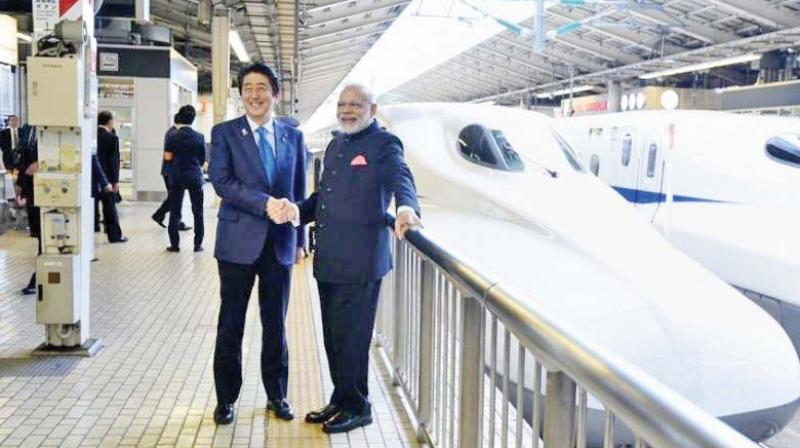Put the brakes on bullet train

The Mumbai Suburban Rail Network is operated by two Divisional Railways — the Western Railway (WR) and the Central Railway (CR), formerly known as the Bombay, Baroda and Central India Railway (BB&CI) and the Grand Indian Peninsular (GIP) Railway. Historically, the BB&CI and GIP were set up to transport exportable produce to Bombay Harbour and cotton to textile mills. The city’s growth began to mirror that of its textile industry.
The city also began to take shape according to the needs of its burgeoning population. With the establishment of flourishing textile mills, affluent and enterprising people began to settle down in the city, who were naturally jewellery buyers. The diamond and jewellery industry established in Surat and Vadodara expanded, as did textile mills, which were already in place at Ahmedabad. The workforce of the textile mills, which came from interior Maharashtra and the Konkan, resided in housing tenements called chawls.
These chawls, generally located in close proximity to mills, were situated in Dadar, Parel, Chinchpokli, Byculla and Mahalaxmi, and workers generally walked to their respective mills, while using the railway or trams to commute farther distances. The apathy of the “ruling class” towards the workforce and the latter’s tendency to walk to work resulted in Mahalaxmi, Lower Parel, Elphinstone Road, Chinchpokli, Parel stations not developing proportionally to the increase in their usage and the population. This apathy was so great that even after offices replaced mills and the stations started seeing a manifold rise in footfalls, their facilities remained almost unchanged.
Over the years, stations were added on the lines, and a diversionary line serving the dock areas known as the Harbour Line was established. Just as suburban rail services were extended up to Borivali, then Virar and now Dahanu on the WR; and Thane, Kalyan, then Karjat and Kasara, and now Khopoli on the CR mainline, the Harbour line has expanded across the Thane Creek, reaching Thane in the north and Panvel towards the south in the Mumbai Metropolitan Region (MMR). The MMR has an area nearly ten times that of the Municipal Corporation of Greater Mumbai (MCGM). Though the population in the MCGM has attained low growth rate, the MMR is rapidly increasing population-wise. However, employability in MCGM is still very strong and hence commuting is also considerable. Thus, due to railways and the state government’s prolonged neglect, commuting facilities have been inadequate and thereby unsafe. The railway system has a casualty figure touching 3,500 per annum.
In this context, one has to view the stampede of September 29. The mill areas have probably grown merely 20 per cent of their potential. All these stations, which were catering to six coach trains, were increased to accommodate 12-coach rakes over time and there has hardly been investment in facilities matching the growth, other than lengthening the platforms. Today, platforms are nearly 300-m long and many of these stations have access to one foot overbridge (FOB). The situation at Parel station in particular has been referred to as a “tragedy waiting to happen” in many reminders by the people to the powers that be. Curiously, the recent stampede happened on the Elphinstone Road side of the FOB connecting Parel and Elphinstone Road stations, while Elphinstone Road has two accesses to two FOBs and two to the ROB. The stairway where the stampede took place is located at the western end of the only connector FOB leading to the exit point on the road directed towards the north.
The second stairway at the same end is directed towards south. There are situations when north-bound and south-bound trains on the CR and WR discharge people at Parel and Elphinstone Road almost simultaneously. Naturally, the commuter density on these two stairways must have been so high that one person slipping could prove disastrous. Such a dense commuter flow may not be there at all the suburban stations, but “a tragedy waiting to happen” exists at practically every railway station during the three-and-a-half-hour peak period every day.
Certain short-term measures, if taken on a war footing, can prevent such tragedies. The long-term measures are essentially to reduce usage of the suburban railway system to design capacity so as to totally eliminate the current annual casualty figures. Long-term measures are also to augment facilities for commuters to reach platforms. For example, providing two additional FOBs on Parel station. In this context, owing to the fact that the bullet train will connect Mumbai and Ahmedabad in two to three hours, we can look forward to a rise in economic activity. Mumbai-Ahmedabad is the first phase of the Delhi-Mumbai Industrial Corridor.
With our commitments to contain global warming and climate change, travelling rapidly on the ground is definitely better than travelling by air. However, so long as such mega projects keep getting implemented, the upgradation of existing infrastructure is likely to be overlooked. Therefore, it is ill advised to proceed with priority when the state of current infrastructure has such a dismal safety record. The plan to get a bullet train from Japan should be dropped entirely and deferred until we establish our own technologies. It will definitely help increase employability of Indians.

